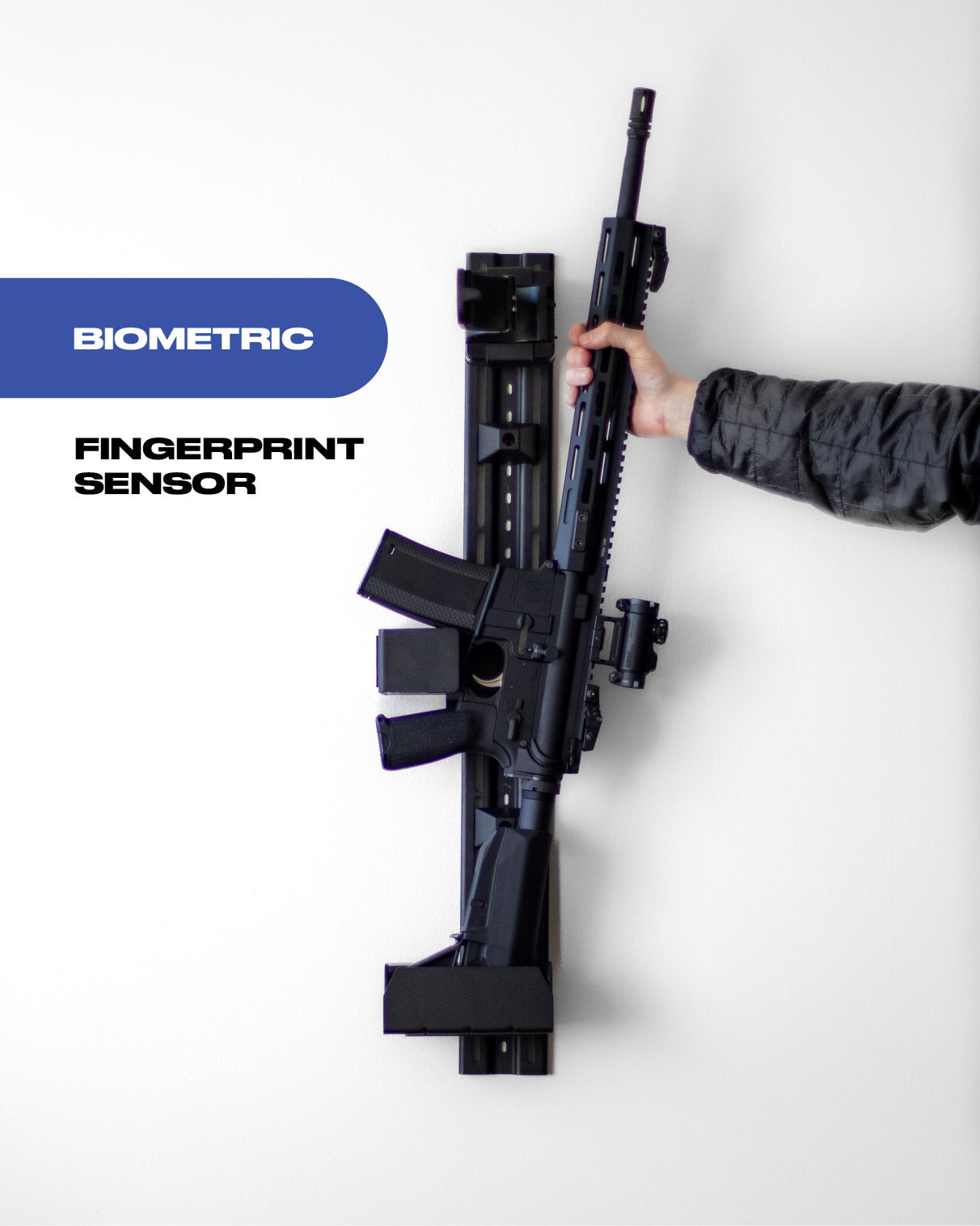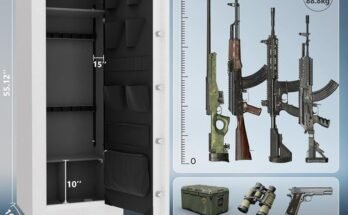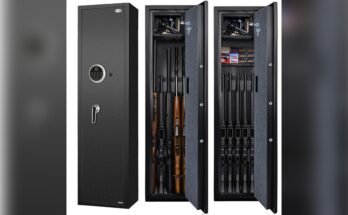Are you looking for the best way to keep your rifles secure while still having quick access when you need them? Biometric rifle safes promise to offer just that—security combined with speed.
But are they really worth your investment? If you’ve ever wondered whether these high-tech safes live up to the hype, this article will help you decide. By the end, you’ll know exactly what to expect, so you can protect your firearms without compromising convenience or safety.
Keep reading to find out if a biometric rifle safe is the right choice for you.

How Biometric Rifle Safes Work
Biometric rifle safes use advanced technology to keep firearms secure. They rely on unique physical traits to grant access. This makes them different from traditional safes that use keys or codes. Understanding how these safes work helps to see their benefits.
Fingerprint Recognition Technology
Biometric safes scan fingerprints to identify users. The sensor reads tiny ridges and patterns on the skin. It compares the scan to stored fingerprint data. Only registered prints can open the safe. This method reduces the risk of unauthorized access.
Speed And Accuracy
These safes open quickly, usually within seconds. The scanner processes prints fast to allow quick entry. Accuracy is high, with few false readings. This ensures the safe opens only for authorized users. Quick access can be crucial in emergencies.
Backup Access Options
Most biometric safes include backup ways to open them. Common options are mechanical keys or PIN codes. These backups help if the fingerprint scanner fails. They provide extra security and peace of mind. Backup options ensure you never get locked out.
Advantages Of Biometric Safes
Biometric rifle safes offer several clear benefits that make them a smart choice for firearm storage. These safes combine technology with safety to provide better protection and ease of use. Understanding these advantages can help you decide if a biometric safe fits your needs.
Quick Access In Emergencies
Biometric safes allow you to open your safe fast using your fingerprint. This speed is crucial during emergencies when every second counts. No need to fumble with keys or remember codes. Just place your finger on the scanner, and the safe opens instantly.
Enhanced Security Features
Biometric safes use unique fingerprint recognition, making unauthorized access very difficult. Only registered users can open the safe. Many models also lock automatically after a set time. Some safes include alarms to alert you of tampering attempts.
User Convenience
These safes are easy to use and require little maintenance. You can add multiple fingerprints for trusted users. The digital system remembers your prints without the need for physical keys. This reduces the risk of lost or stolen keys.
Potential Drawbacks To Consider
Biometric rifle safes offer advanced security but come with some drawbacks. These issues might affect convenience and reliability. Understanding these potential problems helps you decide if this safe fits your needs.
Technology Failures And Malfunctions
Biometric safes rely on sensors and software. These parts can fail or stop working correctly. Dirt, moisture, or damage can block fingerprint recognition. Sometimes the safe may not open even with the right fingerprint. This failure can cause frustration or delay in emergencies.
Power And Battery Concerns
Most biometric safes need batteries to work. Batteries can run out without warning. If power dies, the safe might lock you out. Some models have backup keys, but not all do. Checking battery levels regularly is necessary to avoid problems.
Cost Comparison With Traditional Safes
Biometric safes usually cost more than traditional ones. The extra price pays for technology and convenience. Traditional safes offer strong security at a lower price. For some, the high cost might not be worth it. Budget matters when choosing the right safe.
Key Features To Look For
Choosing the right biometric rifle safe is important for security and ease of use. Certain features ensure the safe works well and lasts long. These features help protect your firearms and give quick access when needed.
Sensor Quality
The sensor is the heart of a biometric safe. A good sensor reads fingerprints quickly and accurately. It should work well even with wet or dirty fingers. Sensors with a low error rate reduce frustration. Fast response time helps in urgent situations. Check if the sensor stores multiple fingerprints for different users.
Safe Construction And Materials
The safe must be strong and durable. Look for thick steel walls and solid locking bolts. Heavy-duty materials stop break-ins and damage. A safe with fire resistance adds extra protection. The door should close tightly without gaps. Quality construction keeps your firearms secure.
Capacity And Size Options
Rifle safes come in various sizes. Choose one that fits your rifles and other gear comfortably. Too small a safe limits storage and can cause damage. Larger safes offer space for ammo and accessories. Consider where you will place the safe before buying. Size affects portability and installation options.
Real-world Performance And Reliability
Biometric rifle safes offer a high-tech way to secure firearms. Their real-world performance matters most to owners. Reliability ensures quick access and proper protection. This section explores user feedback, stress tests, and upkeep needed for these safes.
User Reviews And Feedback
Many users praise biometric safes for fast unlocking. They report ease of use even under pressure. Some note occasional sensor errors, especially with wet or dirty fingers. Overall, most reviews highlight convenience and improved security. Users recommend regular cleaning to maintain sensor accuracy.
Testing Under Stress Conditions
Stress testing shows biometric safes hold up well. They unlock quickly during timed drills. Some models struggle in cold weather or low light. Battery life is critical; dead batteries can cause lockouts. Reliable safes have backup keys or passcodes for emergencies.
Maintenance Requirements
Biometric safes need regular cleaning of fingerprint sensors. Dust, dirt, and moisture reduce sensor performance. Batteries require periodic replacement to avoid failure. Checking mechanical parts keeps the safe functioning smoothly. Simple care extends safe life and reliability.

Alternatives To Biometric Safes
Biometric rifle safes offer quick access and strong security. Still, other options exist for gun owners. These alternatives can fit different budgets and needs. Each type has its own pros and cons. Understanding these helps you choose the best safe for your firearms.
Mechanical And Digital Lock Safes
Mechanical lock safes use a dial to open. They don’t need batteries or electronics. This makes them reliable and easy to maintain. Digital lock safes use a keypad for a code. They offer faster access than mechanical locks. Both types provide solid protection for guns. They often cost less than biometric safes.
Cable Locks And Trigger Locks
Cable locks loop through the gun to block firing. They are simple and affordable. Trigger locks cover the trigger, preventing it from moving. These locks are lightweight and portable. They add an extra safety layer inside a safe or drawer. Cable and trigger locks alone do not secure guns from theft. They are best as additional safety tools.
Hidden Storage Solutions
Hidden storage keeps guns out of sight. Common places include furniture or wall safes. These safes blend into home decor. They can be unlocked with keys or codes. Hidden safes reduce the chance of theft or unauthorized use. They are good for discreet gun storage. Still, they may not offer the quick access of biometric safes.
Legal And Safety Considerations
Choosing a biometric rifle safe involves more than technology. Legal and safety factors play a key role. Understanding these points helps you decide if biometric safes suit your needs. Safety protects your family and meets the law.
Compliance With Gun Storage Laws
Laws about gun storage vary by state and country. Many places require firearms to be locked securely. Biometric safes often meet these legal demands. They provide quick access for owners while keeping guns out of reach of others. Checking local laws ensures your safe follows the rules. Proper compliance helps avoid legal trouble.
Child Safety Measures
Children are curious and may find guns if not stored safely. Biometric safes use fingerprint scans to limit access. This feature stops children from opening the safe. Many models also have tamper alerts. These safes add layers of protection beyond traditional locks. Keeping guns away from children prevents accidents and injuries.
Preventing Unauthorized Access
Unauthorized people should not get your firearms. Biometric safes use unique fingerprints to control entry. This stops thieves or guests from opening the safe. Some safes lock automatically after failed attempts. The technology reduces risks of theft and misuse. It gives gun owners peace of mind about security.
Making The Right Choice
Choosing the right rifle safe is crucial for protecting your firearms. Biometric rifle safes offer quick access and advanced security. Deciding if they fit your needs requires careful thought. This section helps you make a smart choice.
Assessing Your Security Needs
Think about who needs access to your rifles. Are there children or unauthorized people in your home? Biometric safes provide fast entry for trusted users. They also keep your guns safe from theft and accidents. Consider the level of security you require. High-risk areas may need stronger protection.
Budgeting For Protection
Biometric safes cost more than traditional models. Set a budget that balances cost and safety. Cheaper safes might lack features or durability. Investing in quality ensures your firearms stay secure. Remember, this is a long-term purchase for safety.
Future-proofing Your Investment
Technology changes rapidly. Choose a safe with upgradable features. Look for models with easy software updates. Check if the manufacturer supports new biometric scanners. A future-proof safe adapts to new security needs. This saves money and hassle later.

Frequently Asked Questions
What Are Biometric Rifle Safes?
Biometric rifle safes use fingerprint scanners for quick, secure access. They offer enhanced security by restricting entry to authorized users only, preventing unauthorized access.
Are Biometric Safes Faster Than Traditional Locks?
Yes, biometric safes unlock faster than keys or combination locks. They provide quick access during emergencies, saving valuable time while maintaining safety.
How Reliable Are Biometric Scanners On Rifle Safes?
Biometric scanners are highly reliable with low false acceptance rates. Modern sensors adapt to fingerprint changes, ensuring consistent and secure access.
Do Biometric Rifle Safes Require Batteries?
Yes, biometric safes need batteries for the fingerprint scanner to function. Battery life varies, but most models alert users when power is low.
Conclusion
Biometric rifle safes offer quick access and strong security. They help keep guns away from children and strangers. The fingerprint technology usually works well but can sometimes fail. Prices are higher than traditional safes, which may matter to some buyers.
Consider your budget and safety needs before deciding. For many, the convenience and extra security are worth it. Think about how often you need fast access. Overall, biometric safes provide a good balance of safety and ease. Choose what fits your lifestyle and peace of mind best.



